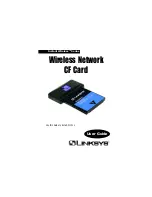
22
DSSS (Direct-Sequence Spread-Spectrum) - DSSS generates a redundant bit
pattern for each bit to be transmitted. This bit pattern is called a chip (or chip-
ping code). The longer the chip, the greater the probability that the original data
can be recovered. Even if one or more bits in the chip are damaged during
transmission, statistical techniques embedded in the radio can recover the orig-
inal data without -the need for retransmission. To an unintended receiver, DSSS
appears as low power wideband noise and is rejected (ignored) by most nar-
rowband receivers.
Encryption - A security method that applies a specific algorithm to data in
order to alter the data's appearance and prevent other devices from reading the
information.
ESS - More than one BSS in a network.
Ethernet - IEEE standard network protocol that specifies how data is placed
on and retrieved from a common transmission medium. Having a transfer rate
of 10 Mbps., this forms the underlying transport vehicle used by several upper-
level protocols.
FHSS - Also known as "Frequency Hopping Spread Spectrum". Frequency
hopping spread spectrum (FHSS) continuously changes the center frequency of
a conventional carrier several times per second according to a pseudo-random
set of channels, while chirp spread spectrum changes the carrier frequency.
Because a fixed frequency is not used, illegal monitoring of spread spectrum
signals is extremely difficult, if not downright impossible depending on the
particular method.
Firmware - Programming that is inserted into programmable read-only mem-
ory (programmable read-only memory), thus becoming a permanent part of a
computing device.
Fragmentation - Breaking a packet into smaller units when transmitting over
a network medium that cannot support the original size of the packet.
Unlike e-mail programs in which graphics and program files have to be
"attached," FTP is designed to handle binary files directly and does not add the
overhead of encoding and decoding the data.
Wireless Network CF Card
Glossary
Ad-hoc Network - An ad-hoc network is a wireless network or other small net-
work in which some of the network devices are part of the network only for the
duration of a communications session while in some close proximity to the rest
of the network.
Backbone - The part of a network that connects most of the systems and net-
works together and handles the most data.
Bandwidth - The transmission capacity of a given facility, in terms of how
much data the facility can transmit in a fixed amount of time; expressed in bits
per second (bps).
Bit - A binary digit. The value - 0 or 1-used in the binary numbering system.
Also, the smallest form of data.
BSS (Basic Service Set) - A group of Network CF Card users and an Access
Point.
CompactFlash - A flash memory format card that plugs into a CompactFlash
socket or into a standard Type II PC Card slot with an adapter.
CSMA/CD (Carrier Sense Multiple Access/Collision Detection) - The LAN
access method used in Ethernet. When a device wants to gain access to the net-
work, it checks to see if the network is quiet (senses the carrier). If it is not, it
waits a random amount of time before retrying. If the network is quiet and two
devices access the line at exactly the same time, their signals collide. When the
collision is detected, they both back off and each wait a random amount of time
before retrying.
Database - A database is a collection of data that is organized so that its con-
tents can easily be accessed, managed, and updated.
Driver - A software module that provides an interface between a network inter-
face card and the upper-layer protocol software running in the computer.
23
Instant Wireless
TM
Series




































